Organisation and Behaviour Report: AM (Holding) Ltd Analysis
VerifiedAdded on 2020/06/06
|13
|4115
|50
Report
AI Summary
This report provides an in-depth analysis of organizational behavior within AM (Holding) Ltd, covering key aspects such as organizational culture, politics, and power dynamics and their influence on team behavior. It explores various motivational theories, including Maslow's Hierarchy, Herzberg's Two-Factor Theory, and Vroom's Expectancy Theory, and their application within the business enterprise. The report also delves into methods for building effective teams, focusing on strategies like task segmentation and communication. Furthermore, it examines the concepts and philosophies of organizational behavior within AM (Holding) Ltd, providing a comprehensive overview of the company's approach to managing its workforce and achieving its goals. The report uses different theories and models to analyze the organizational behavior and make suggestions to improve team performance and overall organizational effectiveness.
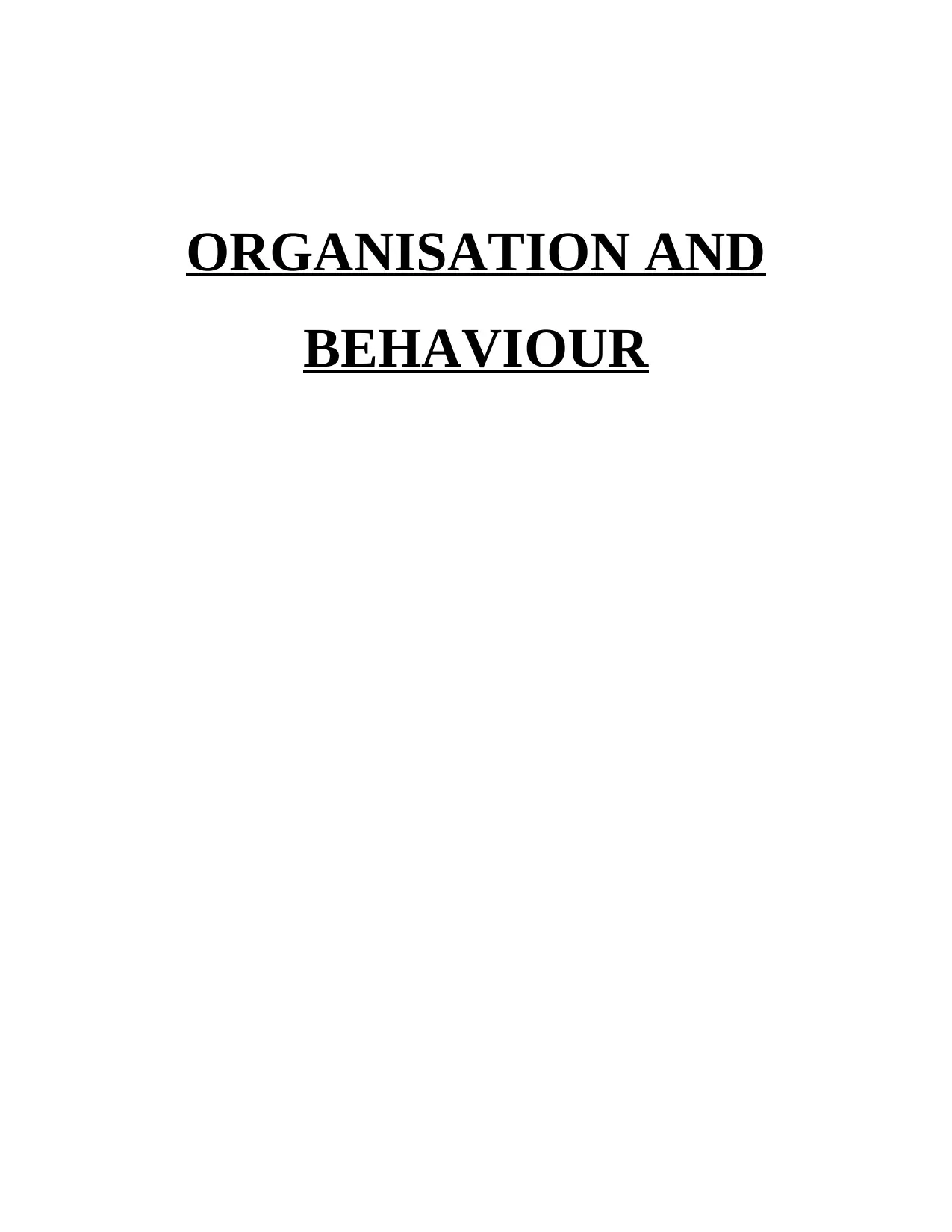
ORGANISATION AND
BEHAVIOUR
BEHAVIOUR
Paraphrase This Document
Need a fresh take? Get an instant paraphrase of this document with our AI Paraphraser
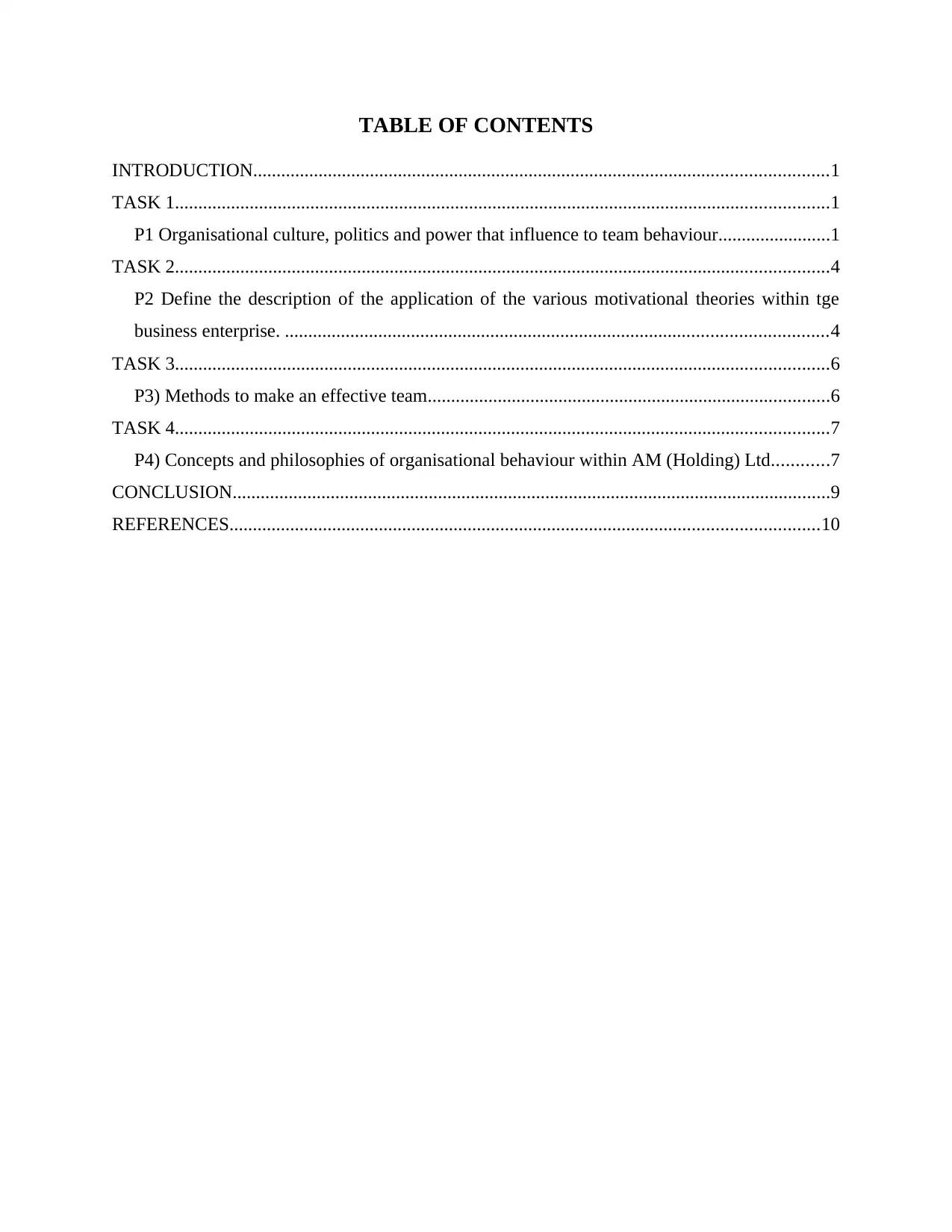
TABLE OF CONTENTS
INTRODUCTION...........................................................................................................................1
TASK 1............................................................................................................................................1
P1 Organisational culture, politics and power that influence to team behaviour........................1
TASK 2............................................................................................................................................4
P2 Define the description of the application of the various motivational theories within tge
business enterprise. ....................................................................................................................4
TASK 3............................................................................................................................................6
P3) Methods to make an effective team......................................................................................6
TASK 4............................................................................................................................................7
P4) Concepts and philosophies of organisational behaviour within AM (Holding) Ltd............7
CONCLUSION................................................................................................................................9
REFERENCES..............................................................................................................................10
INTRODUCTION...........................................................................................................................1
TASK 1............................................................................................................................................1
P1 Organisational culture, politics and power that influence to team behaviour........................1
TASK 2............................................................................................................................................4
P2 Define the description of the application of the various motivational theories within tge
business enterprise. ....................................................................................................................4
TASK 3............................................................................................................................................6
P3) Methods to make an effective team......................................................................................6
TASK 4............................................................................................................................................7
P4) Concepts and philosophies of organisational behaviour within AM (Holding) Ltd............7
CONCLUSION................................................................................................................................9
REFERENCES..............................................................................................................................10
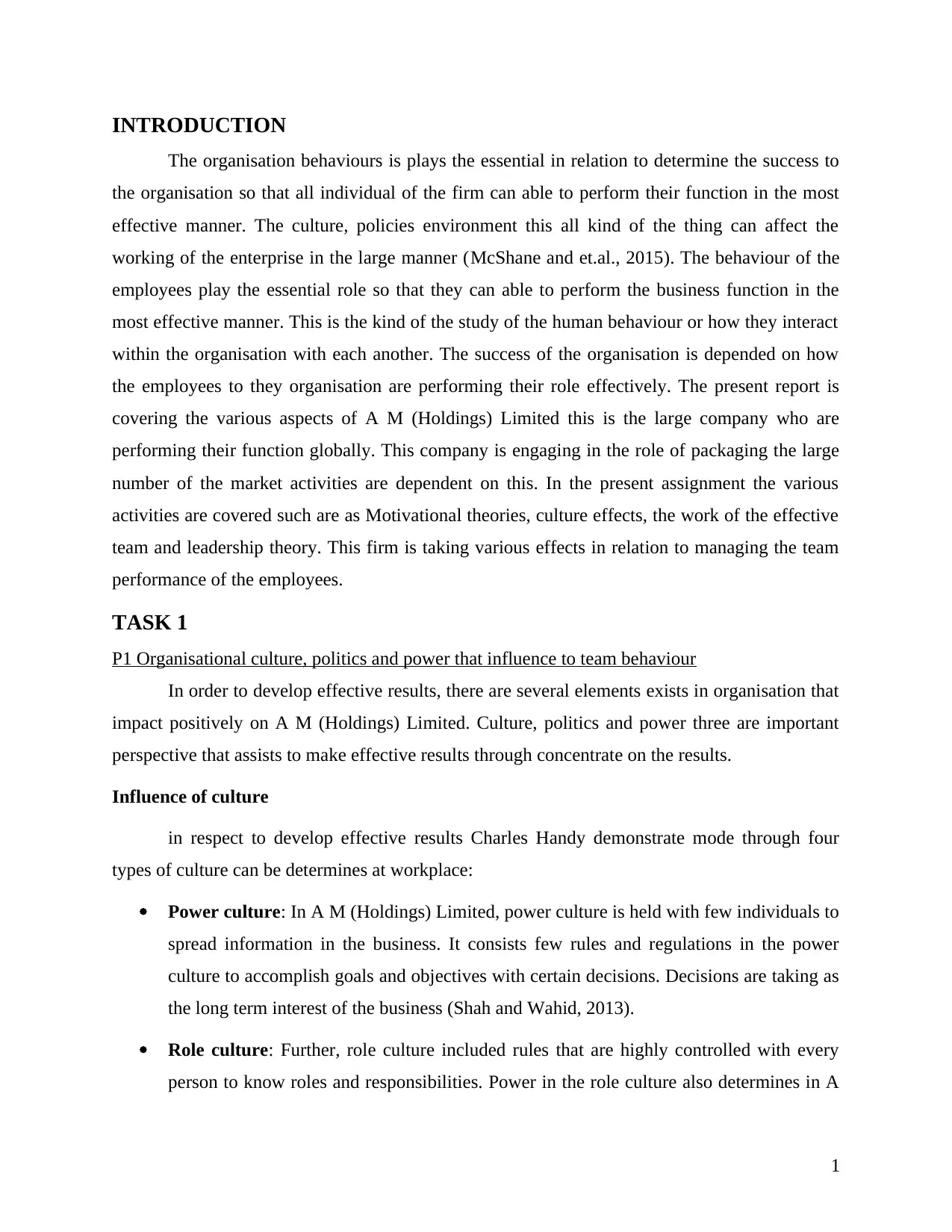
INTRODUCTION
The organisation behaviours is plays the essential in relation to determine the success to
the organisation so that all individual of the firm can able to perform their function in the most
effective manner. The culture, policies environment this all kind of the thing can affect the
working of the enterprise in the large manner (McShane and et.al., 2015). The behaviour of the
employees play the essential role so that they can able to perform the business function in the
most effective manner. This is the kind of the study of the human behaviour or how they interact
within the organisation with each another. The success of the organisation is depended on how
the employees to they organisation are performing their role effectively. The present report is
covering the various aspects of A M (Holdings) Limited this is the large company who are
performing their function globally. This company is engaging in the role of packaging the large
number of the market activities are dependent on this. In the present assignment the various
activities are covered such are as Motivational theories, culture effects, the work of the effective
team and leadership theory. This firm is taking various effects in relation to managing the team
performance of the employees.
TASK 1
P1 Organisational culture, politics and power that influence to team behaviour
In order to develop effective results, there are several elements exists in organisation that
impact positively on A M (Holdings) Limited. Culture, politics and power three are important
perspective that assists to make effective results through concentrate on the results.
Influence of culture
in respect to develop effective results Charles Handy demonstrate mode through four
types of culture can be determines at workplace:
Power culture: In A M (Holdings) Limited, power culture is held with few individuals to
spread information in the business. It consists few rules and regulations in the power
culture to accomplish goals and objectives with certain decisions. Decisions are taking as
the long term interest of the business (Shah and Wahid, 2013).
Role culture: Further, role culture included rules that are highly controlled with every
person to know roles and responsibilities. Power in the role culture also determines in A
1
The organisation behaviours is plays the essential in relation to determine the success to
the organisation so that all individual of the firm can able to perform their function in the most
effective manner. The culture, policies environment this all kind of the thing can affect the
working of the enterprise in the large manner (McShane and et.al., 2015). The behaviour of the
employees play the essential role so that they can able to perform the business function in the
most effective manner. This is the kind of the study of the human behaviour or how they interact
within the organisation with each another. The success of the organisation is depended on how
the employees to they organisation are performing their role effectively. The present report is
covering the various aspects of A M (Holdings) Limited this is the large company who are
performing their function globally. This company is engaging in the role of packaging the large
number of the market activities are dependent on this. In the present assignment the various
activities are covered such are as Motivational theories, culture effects, the work of the effective
team and leadership theory. This firm is taking various effects in relation to managing the team
performance of the employees.
TASK 1
P1 Organisational culture, politics and power that influence to team behaviour
In order to develop effective results, there are several elements exists in organisation that
impact positively on A M (Holdings) Limited. Culture, politics and power three are important
perspective that assists to make effective results through concentrate on the results.
Influence of culture
in respect to develop effective results Charles Handy demonstrate mode through four
types of culture can be determines at workplace:
Power culture: In A M (Holdings) Limited, power culture is held with few individuals to
spread information in the business. It consists few rules and regulations in the power
culture to accomplish goals and objectives with certain decisions. Decisions are taking as
the long term interest of the business (Shah and Wahid, 2013).
Role culture: Further, role culture included rules that are highly controlled with every
person to know roles and responsibilities. Power in the role culture also determines in A
1
⊘ This is a preview!⊘
Do you want full access?
Subscribe today to unlock all pages.

Trusted by 1+ million students worldwide
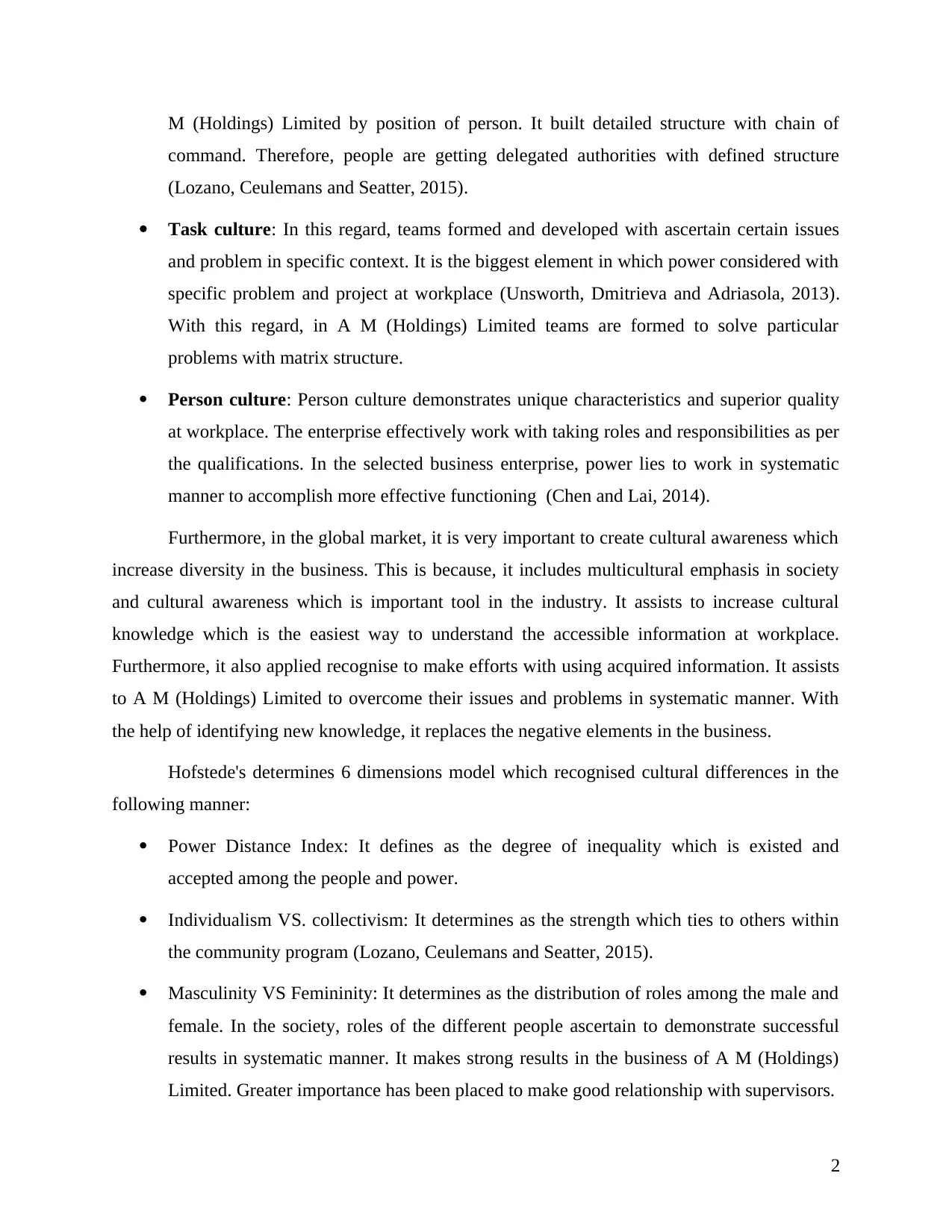
M (Holdings) Limited by position of person. It built detailed structure with chain of
command. Therefore, people are getting delegated authorities with defined structure
(Lozano, Ceulemans and Seatter, 2015).
Task culture: In this regard, teams formed and developed with ascertain certain issues
and problem in specific context. It is the biggest element in which power considered with
specific problem and project at workplace (Unsworth, Dmitrieva and Adriasola, 2013).
With this regard, in A M (Holdings) Limited teams are formed to solve particular
problems with matrix structure.
Person culture: Person culture demonstrates unique characteristics and superior quality
at workplace. The enterprise effectively work with taking roles and responsibilities as per
the qualifications. In the selected business enterprise, power lies to work in systematic
manner to accomplish more effective functioning (Chen and Lai, 2014).
Furthermore, in the global market, it is very important to create cultural awareness which
increase diversity in the business. This is because, it includes multicultural emphasis in society
and cultural awareness which is important tool in the industry. It assists to increase cultural
knowledge which is the easiest way to understand the accessible information at workplace.
Furthermore, it also applied recognise to make efforts with using acquired information. It assists
to A M (Holdings) Limited to overcome their issues and problems in systematic manner. With
the help of identifying new knowledge, it replaces the negative elements in the business.
Hofstede's determines 6 dimensions model which recognised cultural differences in the
following manner:
Power Distance Index: It defines as the degree of inequality which is existed and
accepted among the people and power.
Individualism VS. collectivism: It determines as the strength which ties to others within
the community program (Lozano, Ceulemans and Seatter, 2015).
Masculinity VS Femininity: It determines as the distribution of roles among the male and
female. In the society, roles of the different people ascertain to demonstrate successful
results in systematic manner. It makes strong results in the business of A M (Holdings)
Limited. Greater importance has been placed to make good relationship with supervisors.
2
command. Therefore, people are getting delegated authorities with defined structure
(Lozano, Ceulemans and Seatter, 2015).
Task culture: In this regard, teams formed and developed with ascertain certain issues
and problem in specific context. It is the biggest element in which power considered with
specific problem and project at workplace (Unsworth, Dmitrieva and Adriasola, 2013).
With this regard, in A M (Holdings) Limited teams are formed to solve particular
problems with matrix structure.
Person culture: Person culture demonstrates unique characteristics and superior quality
at workplace. The enterprise effectively work with taking roles and responsibilities as per
the qualifications. In the selected business enterprise, power lies to work in systematic
manner to accomplish more effective functioning (Chen and Lai, 2014).
Furthermore, in the global market, it is very important to create cultural awareness which
increase diversity in the business. This is because, it includes multicultural emphasis in society
and cultural awareness which is important tool in the industry. It assists to increase cultural
knowledge which is the easiest way to understand the accessible information at workplace.
Furthermore, it also applied recognise to make efforts with using acquired information. It assists
to A M (Holdings) Limited to overcome their issues and problems in systematic manner. With
the help of identifying new knowledge, it replaces the negative elements in the business.
Hofstede's determines 6 dimensions model which recognised cultural differences in the
following manner:
Power Distance Index: It defines as the degree of inequality which is existed and
accepted among the people and power.
Individualism VS. collectivism: It determines as the strength which ties to others within
the community program (Lozano, Ceulemans and Seatter, 2015).
Masculinity VS Femininity: It determines as the distribution of roles among the male and
female. In the society, roles of the different people ascertain to demonstrate successful
results in systematic manner. It makes strong results in the business of A M (Holdings)
Limited. Greater importance has been placed to make good relationship with supervisors.
2
Paraphrase This Document
Need a fresh take? Get an instant paraphrase of this document with our AI Paraphraser
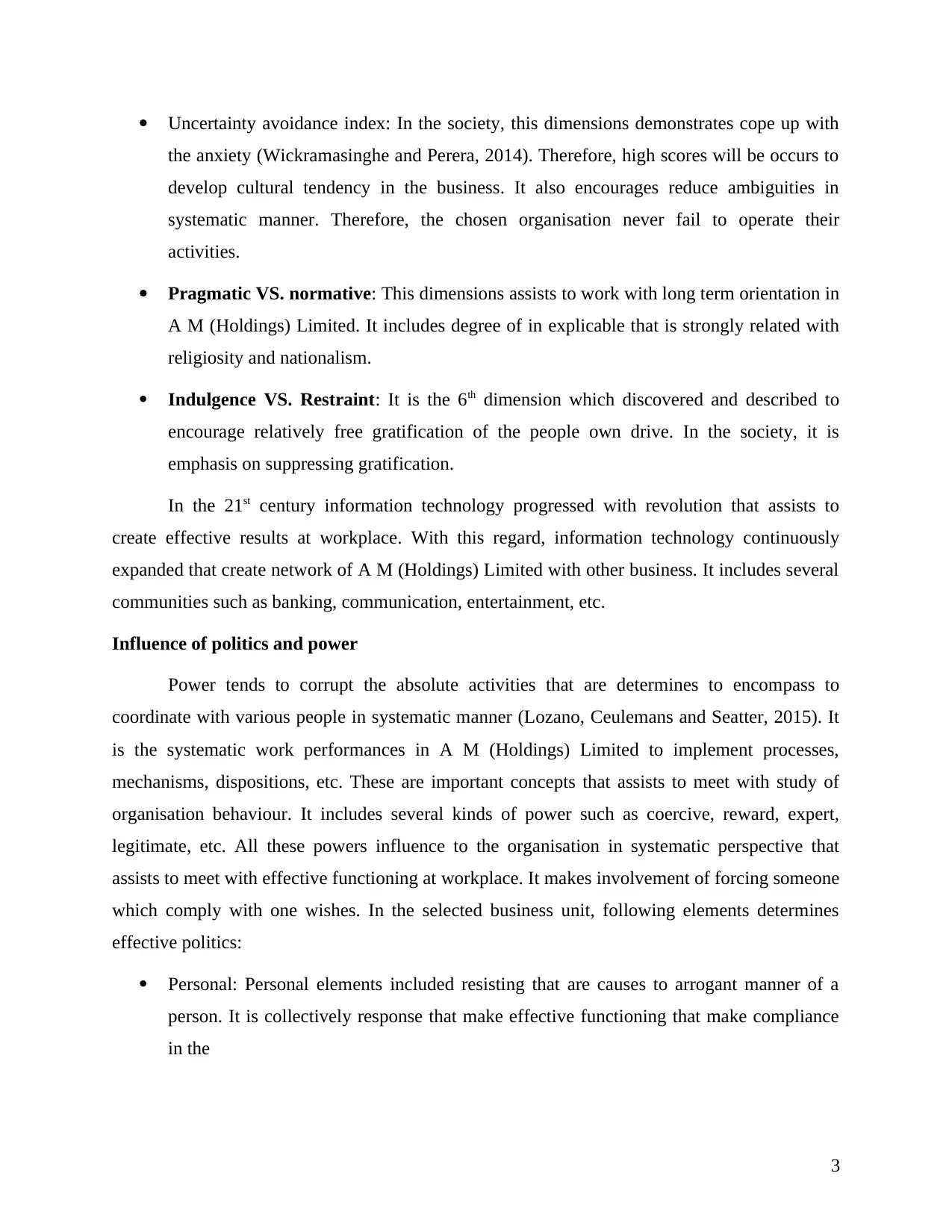
Uncertainty avoidance index: In the society, this dimensions demonstrates cope up with
the anxiety (Wickramasinghe and Perera, 2014). Therefore, high scores will be occurs to
develop cultural tendency in the business. It also encourages reduce ambiguities in
systematic manner. Therefore, the chosen organisation never fail to operate their
activities.
Pragmatic VS. normative: This dimensions assists to work with long term orientation in
A M (Holdings) Limited. It includes degree of in explicable that is strongly related with
religiosity and nationalism.
Indulgence VS. Restraint: It is the 6th dimension which discovered and described to
encourage relatively free gratification of the people own drive. In the society, it is
emphasis on suppressing gratification.
In the 21st century information technology progressed with revolution that assists to
create effective results at workplace. With this regard, information technology continuously
expanded that create network of A M (Holdings) Limited with other business. It includes several
communities such as banking, communication, entertainment, etc.
Influence of politics and power
Power tends to corrupt the absolute activities that are determines to encompass to
coordinate with various people in systematic manner (Lozano, Ceulemans and Seatter, 2015). It
is the systematic work performances in A M (Holdings) Limited to implement processes,
mechanisms, dispositions, etc. These are important concepts that assists to meet with study of
organisation behaviour. It includes several kinds of power such as coercive, reward, expert,
legitimate, etc. All these powers influence to the organisation in systematic perspective that
assists to meet with effective functioning at workplace. It makes involvement of forcing someone
which comply with one wishes. In the selected business unit, following elements determines
effective politics:
Personal: Personal elements included resisting that are causes to arrogant manner of a
person. It is collectively response that make effective functioning that make compliance
in the
3
the anxiety (Wickramasinghe and Perera, 2014). Therefore, high scores will be occurs to
develop cultural tendency in the business. It also encourages reduce ambiguities in
systematic manner. Therefore, the chosen organisation never fail to operate their
activities.
Pragmatic VS. normative: This dimensions assists to work with long term orientation in
A M (Holdings) Limited. It includes degree of in explicable that is strongly related with
religiosity and nationalism.
Indulgence VS. Restraint: It is the 6th dimension which discovered and described to
encourage relatively free gratification of the people own drive. In the society, it is
emphasis on suppressing gratification.
In the 21st century information technology progressed with revolution that assists to
create effective results at workplace. With this regard, information technology continuously
expanded that create network of A M (Holdings) Limited with other business. It includes several
communities such as banking, communication, entertainment, etc.
Influence of politics and power
Power tends to corrupt the absolute activities that are determines to encompass to
coordinate with various people in systematic manner (Lozano, Ceulemans and Seatter, 2015). It
is the systematic work performances in A M (Holdings) Limited to implement processes,
mechanisms, dispositions, etc. These are important concepts that assists to meet with study of
organisation behaviour. It includes several kinds of power such as coercive, reward, expert,
legitimate, etc. All these powers influence to the organisation in systematic perspective that
assists to meet with effective functioning at workplace. It makes involvement of forcing someone
which comply with one wishes. In the selected business unit, following elements determines
effective politics:
Personal: Personal elements included resisting that are causes to arrogant manner of a
person. It is collectively response that make effective functioning that make compliance
in the
3
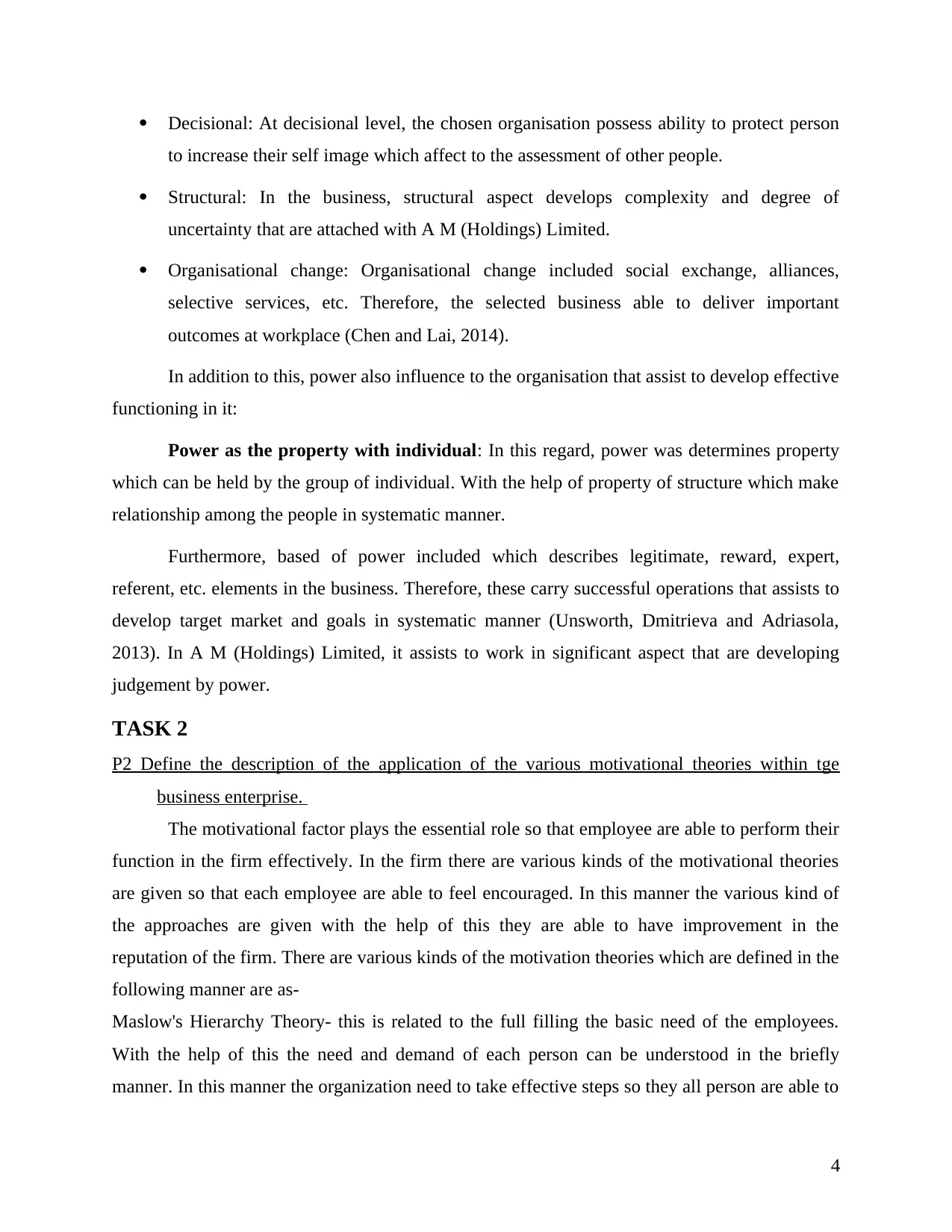
Decisional: At decisional level, the chosen organisation possess ability to protect person
to increase their self image which affect to the assessment of other people.
Structural: In the business, structural aspect develops complexity and degree of
uncertainty that are attached with A M (Holdings) Limited.
Organisational change: Organisational change included social exchange, alliances,
selective services, etc. Therefore, the selected business able to deliver important
outcomes at workplace (Chen and Lai, 2014).
In addition to this, power also influence to the organisation that assist to develop effective
functioning in it:
Power as the property with individual: In this regard, power was determines property
which can be held by the group of individual. With the help of property of structure which make
relationship among the people in systematic manner.
Furthermore, based of power included which describes legitimate, reward, expert,
referent, etc. elements in the business. Therefore, these carry successful operations that assists to
develop target market and goals in systematic manner (Unsworth, Dmitrieva and Adriasola,
2013). In A M (Holdings) Limited, it assists to work in significant aspect that are developing
judgement by power.
TASK 2
P2 Define the description of the application of the various motivational theories within tge
business enterprise.
The motivational factor plays the essential role so that employee are able to perform their
function in the firm effectively. In the firm there are various kinds of the motivational theories
are given so that each employee are able to feel encouraged. In this manner the various kind of
the approaches are given with the help of this they are able to have improvement in the
reputation of the firm. There are various kinds of the motivation theories which are defined in the
following manner are as-
Maslow's Hierarchy Theory- this is related to the full filling the basic need of the employees.
With the help of this the need and demand of each person can be understood in the briefly
manner. In this manner the organization need to take effective steps so they all person are able to
4
to increase their self image which affect to the assessment of other people.
Structural: In the business, structural aspect develops complexity and degree of
uncertainty that are attached with A M (Holdings) Limited.
Organisational change: Organisational change included social exchange, alliances,
selective services, etc. Therefore, the selected business able to deliver important
outcomes at workplace (Chen and Lai, 2014).
In addition to this, power also influence to the organisation that assist to develop effective
functioning in it:
Power as the property with individual: In this regard, power was determines property
which can be held by the group of individual. With the help of property of structure which make
relationship among the people in systematic manner.
Furthermore, based of power included which describes legitimate, reward, expert,
referent, etc. elements in the business. Therefore, these carry successful operations that assists to
develop target market and goals in systematic manner (Unsworth, Dmitrieva and Adriasola,
2013). In A M (Holdings) Limited, it assists to work in significant aspect that are developing
judgement by power.
TASK 2
P2 Define the description of the application of the various motivational theories within tge
business enterprise.
The motivational factor plays the essential role so that employee are able to perform their
function in the firm effectively. In the firm there are various kinds of the motivational theories
are given so that each employee are able to feel encouraged. In this manner the various kind of
the approaches are given with the help of this they are able to have improvement in the
reputation of the firm. There are various kinds of the motivation theories which are defined in the
following manner are as-
Maslow's Hierarchy Theory- this is related to the full filling the basic need of the employees.
With the help of this the need and demand of each person can be understood in the briefly
manner. In this manner the organization need to take effective steps so they all person are able to
4
⊘ This is a preview!⊘
Do you want full access?
Subscribe today to unlock all pages.

Trusted by 1+ million students worldwide
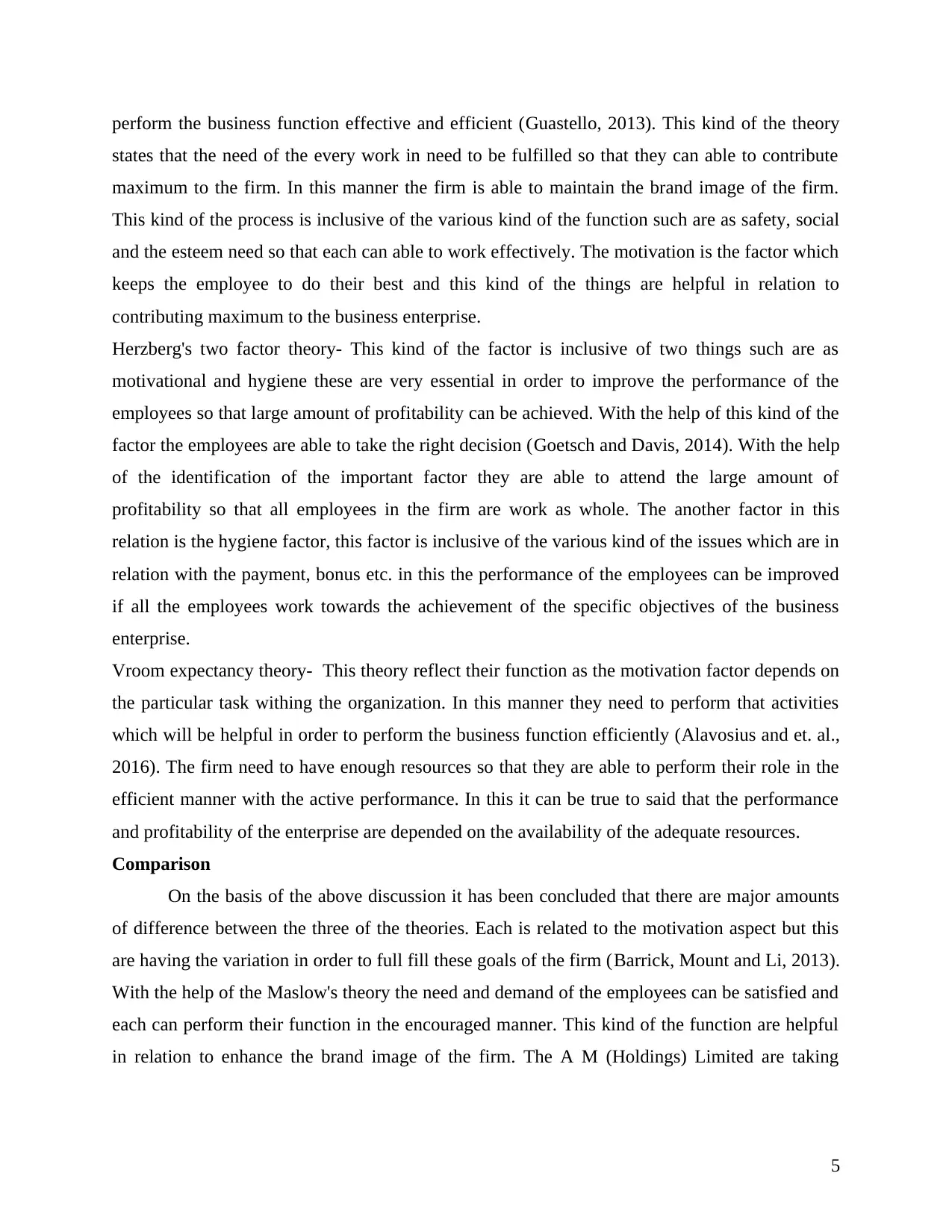
perform the business function effective and efficient (Guastello, 2013). This kind of the theory
states that the need of the every work in need to be fulfilled so that they can able to contribute
maximum to the firm. In this manner the firm is able to maintain the brand image of the firm.
This kind of the process is inclusive of the various kind of the function such are as safety, social
and the esteem need so that each can able to work effectively. The motivation is the factor which
keeps the employee to do their best and this kind of the things are helpful in relation to
contributing maximum to the business enterprise.
Herzberg's two factor theory- This kind of the factor is inclusive of two things such are as
motivational and hygiene these are very essential in order to improve the performance of the
employees so that large amount of profitability can be achieved. With the help of this kind of the
factor the employees are able to take the right decision (Goetsch and Davis, 2014). With the help
of the identification of the important factor they are able to attend the large amount of
profitability so that all employees in the firm are work as whole. The another factor in this
relation is the hygiene factor, this factor is inclusive of the various kind of the issues which are in
relation with the payment, bonus etc. in this the performance of the employees can be improved
if all the employees work towards the achievement of the specific objectives of the business
enterprise.
Vroom expectancy theory- This theory reflect their function as the motivation factor depends on
the particular task withing the organization. In this manner they need to perform that activities
which will be helpful in order to perform the business function efficiently (Alavosius and et. al.,
2016). The firm need to have enough resources so that they are able to perform their role in the
efficient manner with the active performance. In this it can be true to said that the performance
and profitability of the enterprise are depended on the availability of the adequate resources.
Comparison
On the basis of the above discussion it has been concluded that there are major amounts
of difference between the three of the theories. Each is related to the motivation aspect but this
are having the variation in order to full fill these goals of the firm (Barrick, Mount and Li, 2013).
With the help of the Maslow's theory the need and demand of the employees can be satisfied and
each can perform their function in the encouraged manner. This kind of the function are helpful
in relation to enhance the brand image of the firm. The A M (Holdings) Limited are taking
5
states that the need of the every work in need to be fulfilled so that they can able to contribute
maximum to the firm. In this manner the firm is able to maintain the brand image of the firm.
This kind of the process is inclusive of the various kind of the function such are as safety, social
and the esteem need so that each can able to work effectively. The motivation is the factor which
keeps the employee to do their best and this kind of the things are helpful in relation to
contributing maximum to the business enterprise.
Herzberg's two factor theory- This kind of the factor is inclusive of two things such are as
motivational and hygiene these are very essential in order to improve the performance of the
employees so that large amount of profitability can be achieved. With the help of this kind of the
factor the employees are able to take the right decision (Goetsch and Davis, 2014). With the help
of the identification of the important factor they are able to attend the large amount of
profitability so that all employees in the firm are work as whole. The another factor in this
relation is the hygiene factor, this factor is inclusive of the various kind of the issues which are in
relation with the payment, bonus etc. in this the performance of the employees can be improved
if all the employees work towards the achievement of the specific objectives of the business
enterprise.
Vroom expectancy theory- This theory reflect their function as the motivation factor depends on
the particular task withing the organization. In this manner they need to perform that activities
which will be helpful in order to perform the business function efficiently (Alavosius and et. al.,
2016). The firm need to have enough resources so that they are able to perform their role in the
efficient manner with the active performance. In this it can be true to said that the performance
and profitability of the enterprise are depended on the availability of the adequate resources.
Comparison
On the basis of the above discussion it has been concluded that there are major amounts
of difference between the three of the theories. Each is related to the motivation aspect but this
are having the variation in order to full fill these goals of the firm (Barrick, Mount and Li, 2013).
With the help of the Maslow's theory the need and demand of the employees can be satisfied and
each can perform their function in the encouraged manner. This kind of the function are helpful
in relation to enhance the brand image of the firm. The A M (Holdings) Limited are taking
5
Paraphrase This Document
Need a fresh take? Get an instant paraphrase of this document with our AI Paraphraser
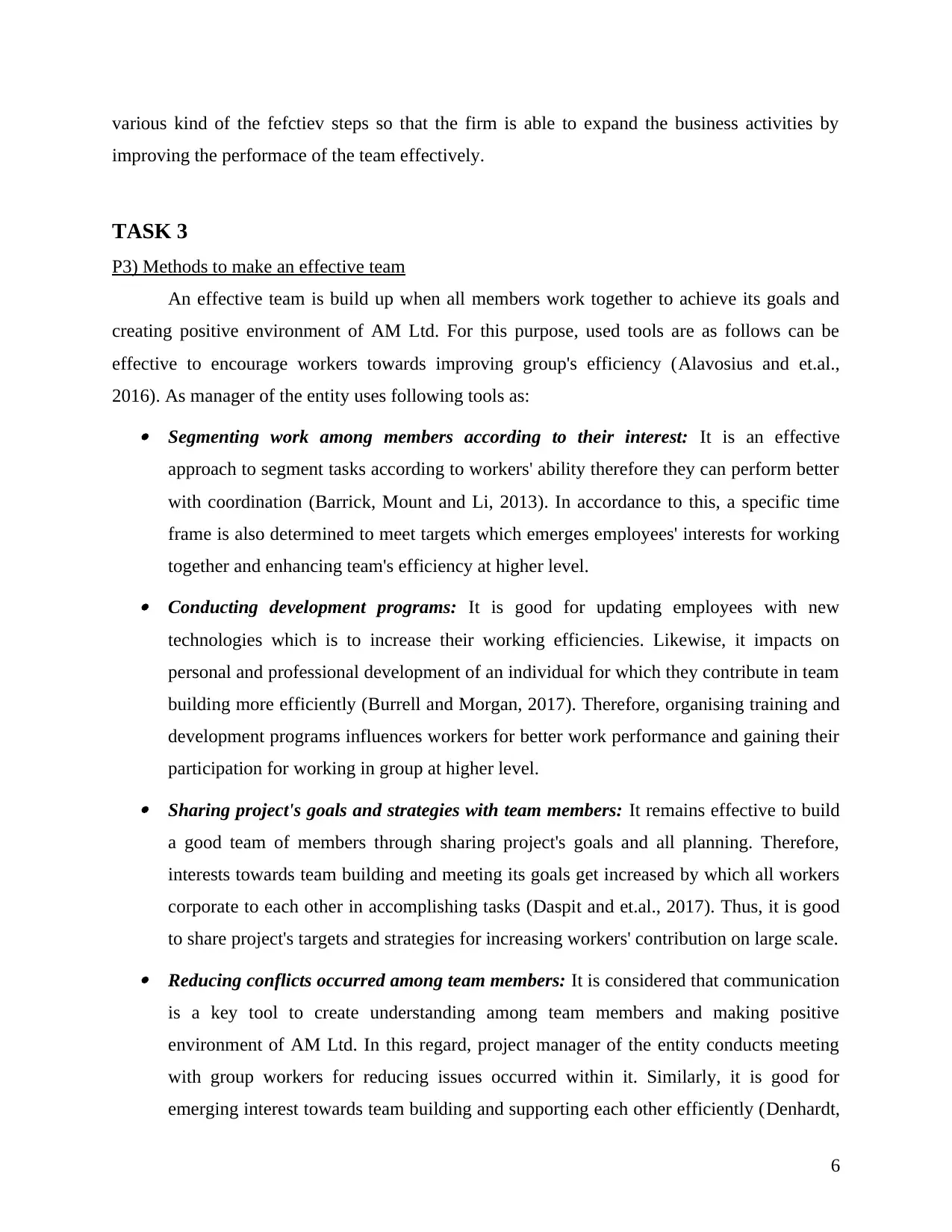
various kind of the fefctiev steps so that the firm is able to expand the business activities by
improving the performace of the team effectively.
TASK 3
P3) Methods to make an effective team
An effective team is build up when all members work together to achieve its goals and
creating positive environment of AM Ltd. For this purpose, used tools are as follows can be
effective to encourage workers towards improving group's efficiency (Alavosius and et.al.,
2016). As manager of the entity uses following tools as: Segmenting work among members according to their interest: It is an effective
approach to segment tasks according to workers' ability therefore they can perform better
with coordination (Barrick, Mount and Li, 2013). In accordance to this, a specific time
frame is also determined to meet targets which emerges employees' interests for working
together and enhancing team's efficiency at higher level. Conducting development programs: It is good for updating employees with new
technologies which is to increase their working efficiencies. Likewise, it impacts on
personal and professional development of an individual for which they contribute in team
building more efficiently (Burrell and Morgan, 2017). Therefore, organising training and
development programs influences workers for better work performance and gaining their
participation for working in group at higher level. Sharing project's goals and strategies with team members: It remains effective to build
a good team of members through sharing project's goals and all planning. Therefore,
interests towards team building and meeting its goals get increased by which all workers
corporate to each other in accomplishing tasks (Daspit and et.al., 2017). Thus, it is good
to share project's targets and strategies for increasing workers' contribution on large scale. Reducing conflicts occurred among team members: It is considered that communication
is a key tool to create understanding among team members and making positive
environment of AM Ltd. In this regard, project manager of the entity conducts meeting
with group workers for reducing issues occurred within it. Similarly, it is good for
emerging interest towards team building and supporting each other efficiently (Denhardt,
6
improving the performace of the team effectively.
TASK 3
P3) Methods to make an effective team
An effective team is build up when all members work together to achieve its goals and
creating positive environment of AM Ltd. For this purpose, used tools are as follows can be
effective to encourage workers towards improving group's efficiency (Alavosius and et.al.,
2016). As manager of the entity uses following tools as: Segmenting work among members according to their interest: It is an effective
approach to segment tasks according to workers' ability therefore they can perform better
with coordination (Barrick, Mount and Li, 2013). In accordance to this, a specific time
frame is also determined to meet targets which emerges employees' interests for working
together and enhancing team's efficiency at higher level. Conducting development programs: It is good for updating employees with new
technologies which is to increase their working efficiencies. Likewise, it impacts on
personal and professional development of an individual for which they contribute in team
building more efficiently (Burrell and Morgan, 2017). Therefore, organising training and
development programs influences workers for better work performance and gaining their
participation for working in group at higher level. Sharing project's goals and strategies with team members: It remains effective to build
a good team of members through sharing project's goals and all planning. Therefore,
interests towards team building and meeting its goals get increased by which all workers
corporate to each other in accomplishing tasks (Daspit and et.al., 2017). Thus, it is good
to share project's targets and strategies for increasing workers' contribution on large scale. Reducing conflicts occurred among team members: It is considered that communication
is a key tool to create understanding among team members and making positive
environment of AM Ltd. In this regard, project manager of the entity conducts meeting
with group workers for reducing issues occurred within it. Similarly, it is good for
emerging interest towards team building and supporting each other efficiently (Denhardt,
6
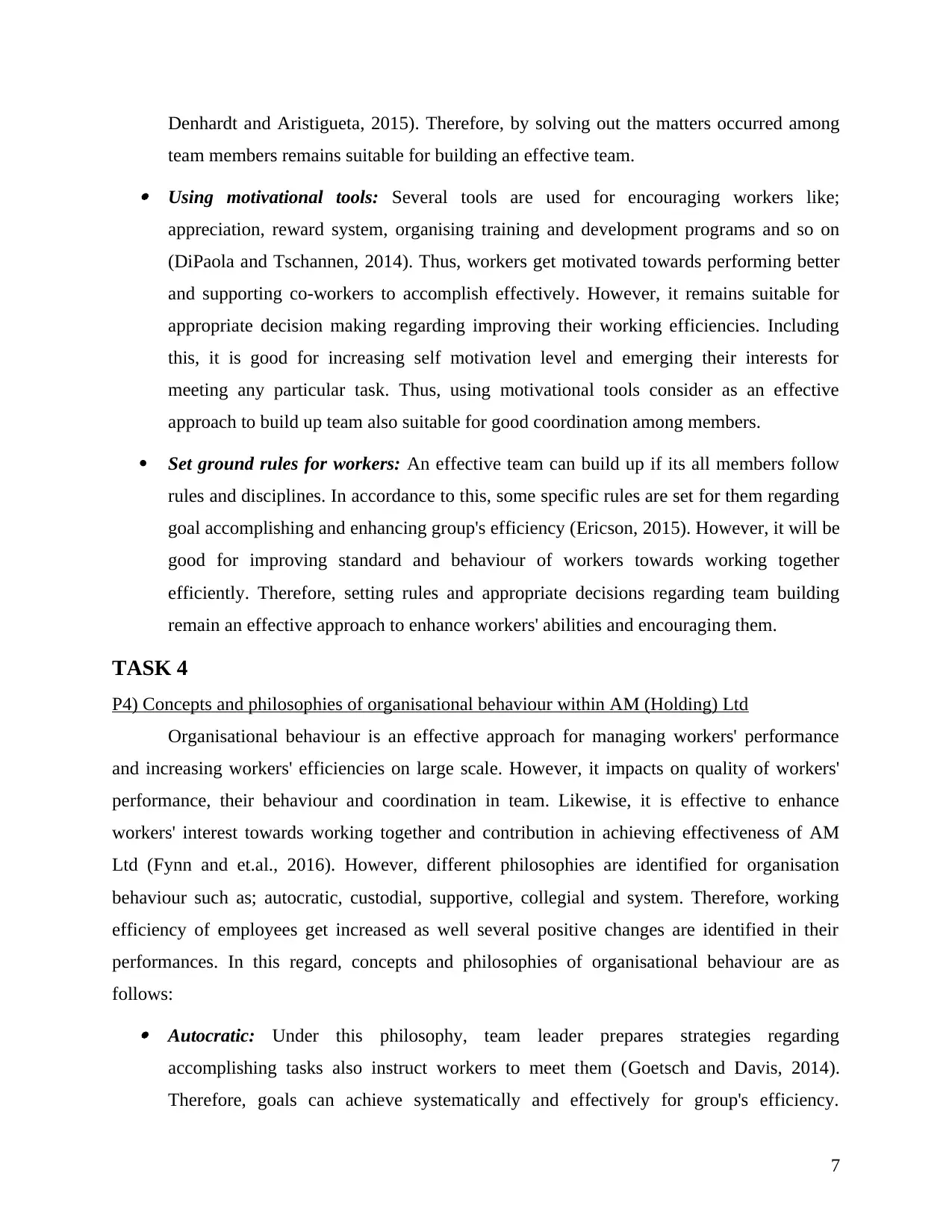
Denhardt and Aristigueta, 2015). Therefore, by solving out the matters occurred among
team members remains suitable for building an effective team. Using motivational tools: Several tools are used for encouraging workers like;
appreciation, reward system, organising training and development programs and so on
(DiPaola and Tschannen, 2014). Thus, workers get motivated towards performing better
and supporting co-workers to accomplish effectively. However, it remains suitable for
appropriate decision making regarding improving their working efficiencies. Including
this, it is good for increasing self motivation level and emerging their interests for
meeting any particular task. Thus, using motivational tools consider as an effective
approach to build up team also suitable for good coordination among members.
Set ground rules for workers: An effective team can build up if its all members follow
rules and disciplines. In accordance to this, some specific rules are set for them regarding
goal accomplishing and enhancing group's efficiency (Ericson, 2015). However, it will be
good for improving standard and behaviour of workers towards working together
efficiently. Therefore, setting rules and appropriate decisions regarding team building
remain an effective approach to enhance workers' abilities and encouraging them.
TASK 4
P4) Concepts and philosophies of organisational behaviour within AM (Holding) Ltd
Organisational behaviour is an effective approach for managing workers' performance
and increasing workers' efficiencies on large scale. However, it impacts on quality of workers'
performance, their behaviour and coordination in team. Likewise, it is effective to enhance
workers' interest towards working together and contribution in achieving effectiveness of AM
Ltd (Fynn and et.al., 2016). However, different philosophies are identified for organisation
behaviour such as; autocratic, custodial, supportive, collegial and system. Therefore, working
efficiency of employees get increased as well several positive changes are identified in their
performances. In this regard, concepts and philosophies of organisational behaviour are as
follows: Autocratic: Under this philosophy, team leader prepares strategies regarding
accomplishing tasks also instruct workers to meet them (Goetsch and Davis, 2014).
Therefore, goals can achieve systematically and effectively for group's efficiency.
7
team members remains suitable for building an effective team. Using motivational tools: Several tools are used for encouraging workers like;
appreciation, reward system, organising training and development programs and so on
(DiPaola and Tschannen, 2014). Thus, workers get motivated towards performing better
and supporting co-workers to accomplish effectively. However, it remains suitable for
appropriate decision making regarding improving their working efficiencies. Including
this, it is good for increasing self motivation level and emerging their interests for
meeting any particular task. Thus, using motivational tools consider as an effective
approach to build up team also suitable for good coordination among members.
Set ground rules for workers: An effective team can build up if its all members follow
rules and disciplines. In accordance to this, some specific rules are set for them regarding
goal accomplishing and enhancing group's efficiency (Ericson, 2015). However, it will be
good for improving standard and behaviour of workers towards working together
efficiently. Therefore, setting rules and appropriate decisions regarding team building
remain an effective approach to enhance workers' abilities and encouraging them.
TASK 4
P4) Concepts and philosophies of organisational behaviour within AM (Holding) Ltd
Organisational behaviour is an effective approach for managing workers' performance
and increasing workers' efficiencies on large scale. However, it impacts on quality of workers'
performance, their behaviour and coordination in team. Likewise, it is effective to enhance
workers' interest towards working together and contribution in achieving effectiveness of AM
Ltd (Fynn and et.al., 2016). However, different philosophies are identified for organisation
behaviour such as; autocratic, custodial, supportive, collegial and system. Therefore, working
efficiency of employees get increased as well several positive changes are identified in their
performances. In this regard, concepts and philosophies of organisational behaviour are as
follows: Autocratic: Under this philosophy, team leader prepares strategies regarding
accomplishing tasks also instruct workers to meet them (Goetsch and Davis, 2014).
Therefore, goals can achieve systematically and effectively for group's efficiency.
7
⊘ This is a preview!⊘
Do you want full access?
Subscribe today to unlock all pages.

Trusted by 1+ million students worldwide
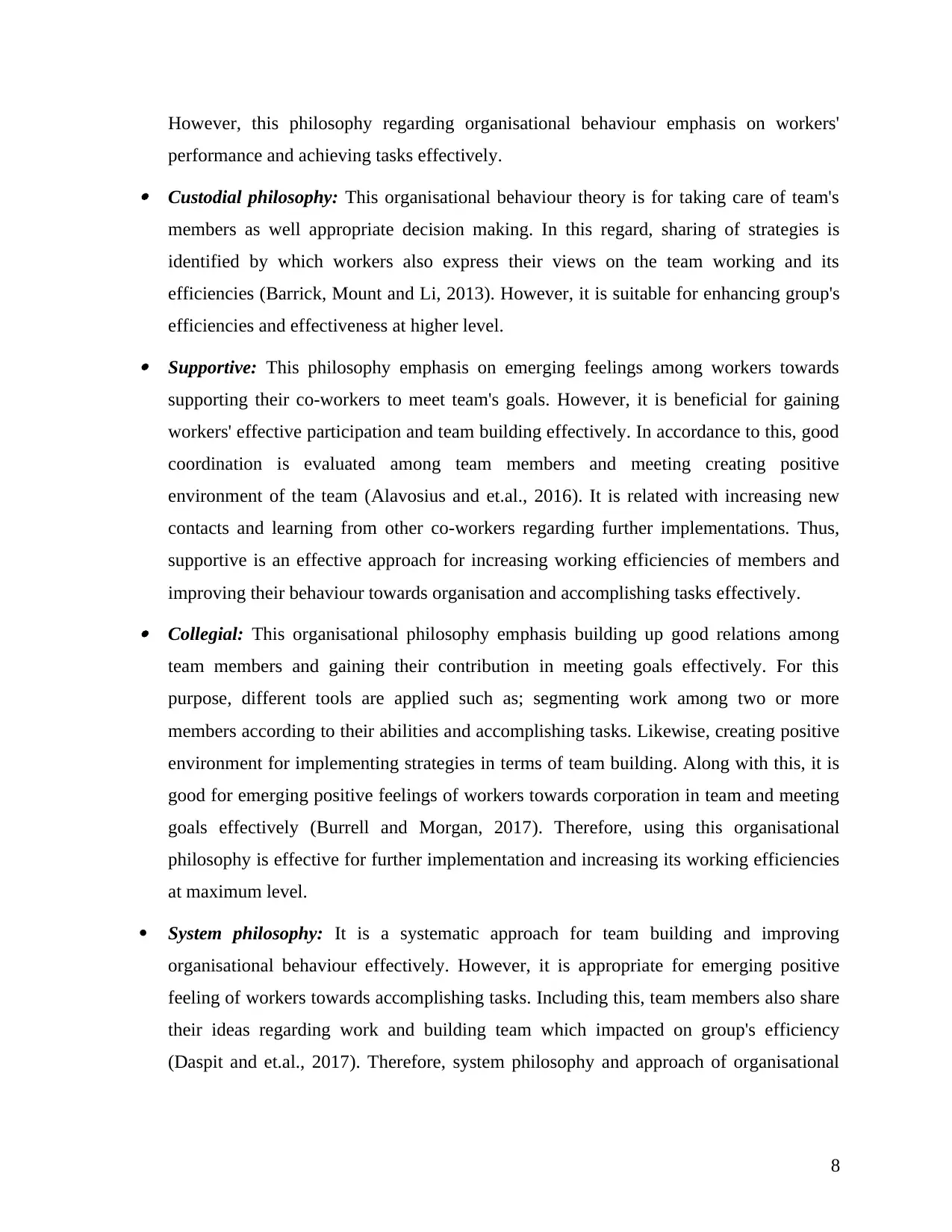
However, this philosophy regarding organisational behaviour emphasis on workers'
performance and achieving tasks effectively. Custodial philosophy: This organisational behaviour theory is for taking care of team's
members as well appropriate decision making. In this regard, sharing of strategies is
identified by which workers also express their views on the team working and its
efficiencies (Barrick, Mount and Li, 2013). However, it is suitable for enhancing group's
efficiencies and effectiveness at higher level. Supportive: This philosophy emphasis on emerging feelings among workers towards
supporting their co-workers to meet team's goals. However, it is beneficial for gaining
workers' effective participation and team building effectively. In accordance to this, good
coordination is evaluated among team members and meeting creating positive
environment of the team (Alavosius and et.al., 2016). It is related with increasing new
contacts and learning from other co-workers regarding further implementations. Thus,
supportive is an effective approach for increasing working efficiencies of members and
improving their behaviour towards organisation and accomplishing tasks effectively. Collegial: This organisational philosophy emphasis building up good relations among
team members and gaining their contribution in meeting goals effectively. For this
purpose, different tools are applied such as; segmenting work among two or more
members according to their abilities and accomplishing tasks. Likewise, creating positive
environment for implementing strategies in terms of team building. Along with this, it is
good for emerging positive feelings of workers towards corporation in team and meeting
goals effectively (Burrell and Morgan, 2017). Therefore, using this organisational
philosophy is effective for further implementation and increasing its working efficiencies
at maximum level.
System philosophy: It is a systematic approach for team building and improving
organisational behaviour effectively. However, it is appropriate for emerging positive
feeling of workers towards accomplishing tasks. Including this, team members also share
their ideas regarding work and building team which impacted on group's efficiency
(Daspit and et.al., 2017). Therefore, system philosophy and approach of organisational
8
performance and achieving tasks effectively. Custodial philosophy: This organisational behaviour theory is for taking care of team's
members as well appropriate decision making. In this regard, sharing of strategies is
identified by which workers also express their views on the team working and its
efficiencies (Barrick, Mount and Li, 2013). However, it is suitable for enhancing group's
efficiencies and effectiveness at higher level. Supportive: This philosophy emphasis on emerging feelings among workers towards
supporting their co-workers to meet team's goals. However, it is beneficial for gaining
workers' effective participation and team building effectively. In accordance to this, good
coordination is evaluated among team members and meeting creating positive
environment of the team (Alavosius and et.al., 2016). It is related with increasing new
contacts and learning from other co-workers regarding further implementations. Thus,
supportive is an effective approach for increasing working efficiencies of members and
improving their behaviour towards organisation and accomplishing tasks effectively. Collegial: This organisational philosophy emphasis building up good relations among
team members and gaining their contribution in meeting goals effectively. For this
purpose, different tools are applied such as; segmenting work among two or more
members according to their abilities and accomplishing tasks. Likewise, creating positive
environment for implementing strategies in terms of team building. Along with this, it is
good for emerging positive feelings of workers towards corporation in team and meeting
goals effectively (Burrell and Morgan, 2017). Therefore, using this organisational
philosophy is effective for further implementation and increasing its working efficiencies
at maximum level.
System philosophy: It is a systematic approach for team building and improving
organisational behaviour effectively. However, it is appropriate for emerging positive
feeling of workers towards accomplishing tasks. Including this, team members also share
their ideas regarding work and building team which impacted on group's efficiency
(Daspit and et.al., 2017). Therefore, system philosophy and approach of organisational
8
Paraphrase This Document
Need a fresh take? Get an instant paraphrase of this document with our AI Paraphraser
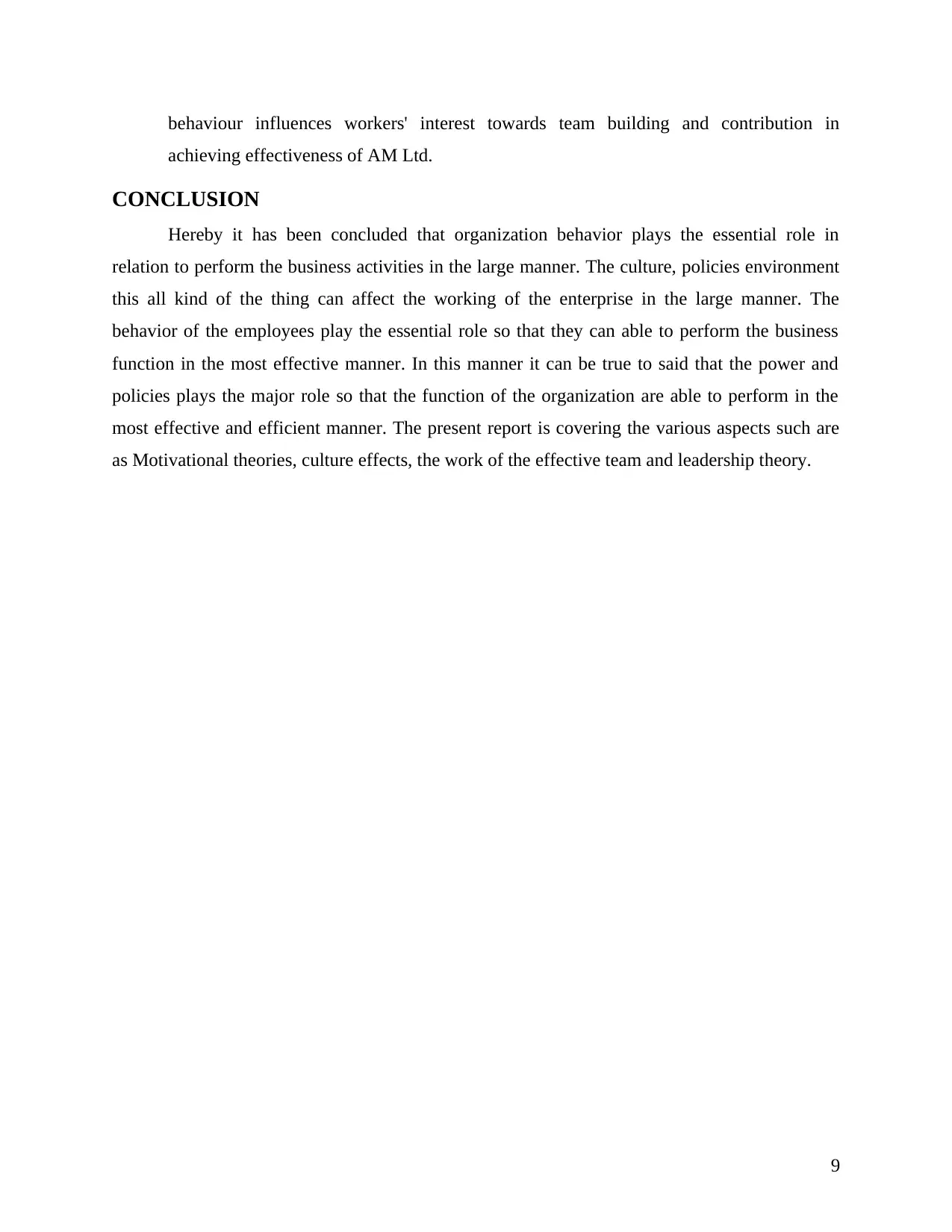
behaviour influences workers' interest towards team building and contribution in
achieving effectiveness of AM Ltd.
CONCLUSION
Hereby it has been concluded that organization behavior plays the essential role in
relation to perform the business activities in the large manner. The culture, policies environment
this all kind of the thing can affect the working of the enterprise in the large manner. The
behavior of the employees play the essential role so that they can able to perform the business
function in the most effective manner. In this manner it can be true to said that the power and
policies plays the major role so that the function of the organization are able to perform in the
most effective and efficient manner. The present report is covering the various aspects such are
as Motivational theories, culture effects, the work of the effective team and leadership theory.
9
achieving effectiveness of AM Ltd.
CONCLUSION
Hereby it has been concluded that organization behavior plays the essential role in
relation to perform the business activities in the large manner. The culture, policies environment
this all kind of the thing can affect the working of the enterprise in the large manner. The
behavior of the employees play the essential role so that they can able to perform the business
function in the most effective manner. In this manner it can be true to said that the power and
policies plays the major role so that the function of the organization are able to perform in the
most effective and efficient manner. The present report is covering the various aspects such are
as Motivational theories, culture effects, the work of the effective team and leadership theory.
9
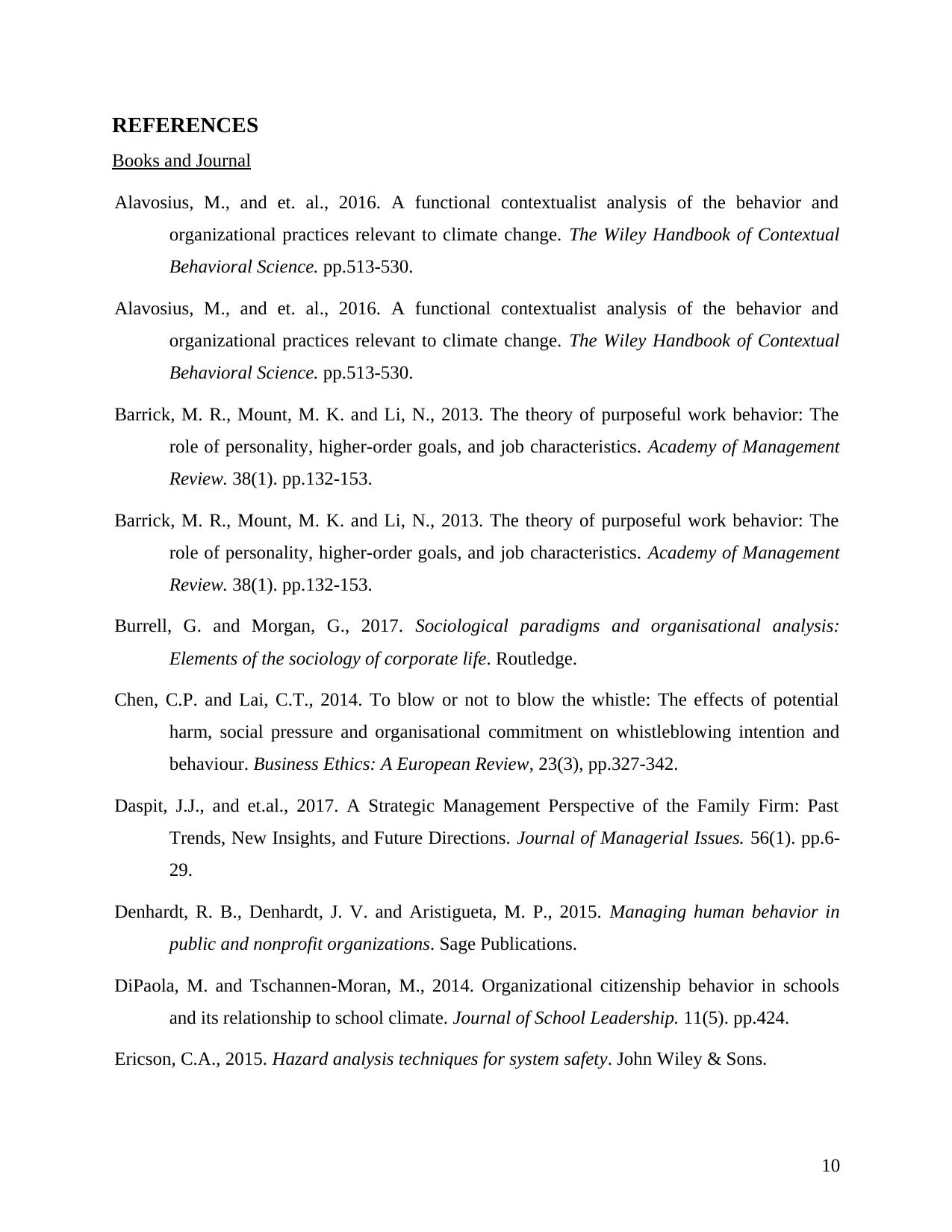
REFERENCES
Books and Journal
Alavosius, M., and et. al., 2016. A functional contextualist analysis of the behavior and
organizational practices relevant to climate change. The Wiley Handbook of Contextual
Behavioral Science. pp.513-530.
Alavosius, M., and et. al., 2016. A functional contextualist analysis of the behavior and
organizational practices relevant to climate change. The Wiley Handbook of Contextual
Behavioral Science. pp.513-530.
Barrick, M. R., Mount, M. K. and Li, N., 2013. The theory of purposeful work behavior: The
role of personality, higher-order goals, and job characteristics. Academy of Management
Review. 38(1). pp.132-153.
Barrick, M. R., Mount, M. K. and Li, N., 2013. The theory of purposeful work behavior: The
role of personality, higher-order goals, and job characteristics. Academy of Management
Review. 38(1). pp.132-153.
Burrell, G. and Morgan, G., 2017. Sociological paradigms and organisational analysis:
Elements of the sociology of corporate life. Routledge.
Chen, C.P. and Lai, C.T., 2014. To blow or not to blow the whistle: The effects of potential
harm, social pressure and organisational commitment on whistleblowing intention and
behaviour. Business Ethics: A European Review, 23(3), pp.327-342.
Daspit, J.J., and et.al., 2017. A Strategic Management Perspective of the Family Firm: Past
Trends, New Insights, and Future Directions. Journal of Managerial Issues. 56(1). pp.6-
29.
Denhardt, R. B., Denhardt, J. V. and Aristigueta, M. P., 2015. Managing human behavior in
public and nonprofit organizations. Sage Publications.
DiPaola, M. and Tschannen-Moran, M., 2014. Organizational citizenship behavior in schools
and its relationship to school climate. Journal of School Leadership. 11(5). pp.424.
Ericson, C.A., 2015. Hazard analysis techniques for system safety. John Wiley & Sons.
10
Books and Journal
Alavosius, M., and et. al., 2016. A functional contextualist analysis of the behavior and
organizational practices relevant to climate change. The Wiley Handbook of Contextual
Behavioral Science. pp.513-530.
Alavosius, M., and et. al., 2016. A functional contextualist analysis of the behavior and
organizational practices relevant to climate change. The Wiley Handbook of Contextual
Behavioral Science. pp.513-530.
Barrick, M. R., Mount, M. K. and Li, N., 2013. The theory of purposeful work behavior: The
role of personality, higher-order goals, and job characteristics. Academy of Management
Review. 38(1). pp.132-153.
Barrick, M. R., Mount, M. K. and Li, N., 2013. The theory of purposeful work behavior: The
role of personality, higher-order goals, and job characteristics. Academy of Management
Review. 38(1). pp.132-153.
Burrell, G. and Morgan, G., 2017. Sociological paradigms and organisational analysis:
Elements of the sociology of corporate life. Routledge.
Chen, C.P. and Lai, C.T., 2014. To blow or not to blow the whistle: The effects of potential
harm, social pressure and organisational commitment on whistleblowing intention and
behaviour. Business Ethics: A European Review, 23(3), pp.327-342.
Daspit, J.J., and et.al., 2017. A Strategic Management Perspective of the Family Firm: Past
Trends, New Insights, and Future Directions. Journal of Managerial Issues. 56(1). pp.6-
29.
Denhardt, R. B., Denhardt, J. V. and Aristigueta, M. P., 2015. Managing human behavior in
public and nonprofit organizations. Sage Publications.
DiPaola, M. and Tschannen-Moran, M., 2014. Organizational citizenship behavior in schools
and its relationship to school climate. Journal of School Leadership. 11(5). pp.424.
Ericson, C.A., 2015. Hazard analysis techniques for system safety. John Wiley & Sons.
10
⊘ This is a preview!⊘
Do you want full access?
Subscribe today to unlock all pages.

Trusted by 1+ million students worldwide
1 out of 13
Related Documents
Your All-in-One AI-Powered Toolkit for Academic Success.
+13062052269
info@desklib.com
Available 24*7 on WhatsApp / Email
![[object Object]](/_next/static/media/star-bottom.7253800d.svg)
Unlock your academic potential
Copyright © 2020–2025 A2Z Services. All Rights Reserved. Developed and managed by ZUCOL.





